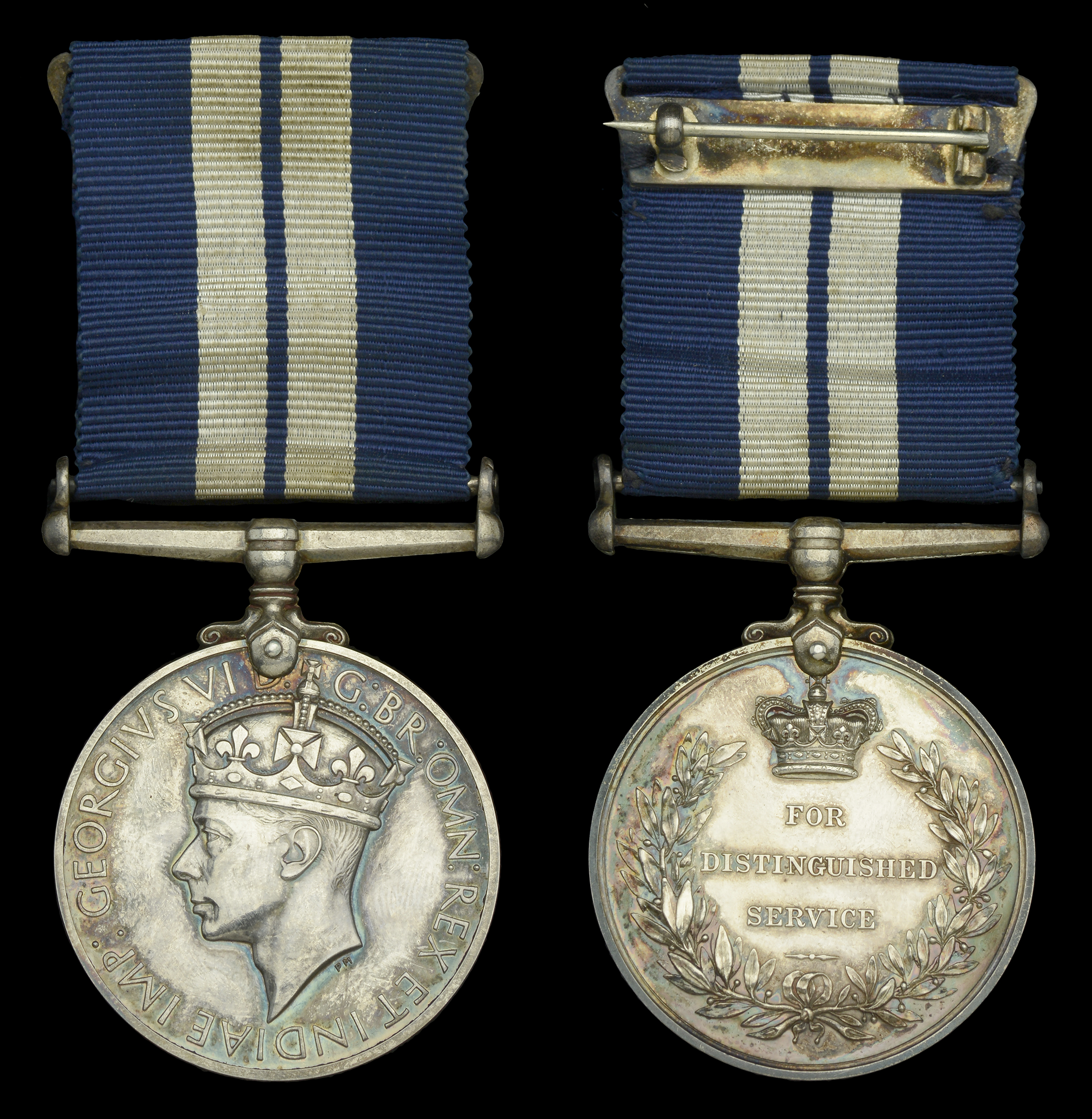A fine Second War Atlantic Convoys D.S.M. awarded to Able Seaman J. G. Wall, Royal Navy, H.M.S. Wild Goose, for services in Captain F. J. Walker’s legendary U-Boat hunting flotilla Distinguished Service Medal, G.VI.R. (A.B. J. G. Wall. C/JX.377589) engraved naming, mounted on original investiture pin, together with named Buckingham Palace enclosure, extremely fine £1,200-£1,600 --- Importation Duty This lot is subject to importation duty of 5% on the hammer price unless exported outside the UK --- --- Provenance: Dix Noonan Webb, March 2000. D.S.M. London Gazette 13 June 1944: ‘For outstanding skill, leadership and determination in H.M. Ships ... Wild Goose ... in the destruction of six U-Boats in the course of operations covering the passage of convoys in the North Atlantic.’ The following details are taken from the original Admiralty records: ‘Able Seaman James Gerard Wall, H.M.S. Wild Goose. For alertness and devotion to duty as look out in sighting a surfaced U-boat at night at a distance of one and a half miles and keeping the officer of the watch informed of her movements until she dived.’ Able Seaman Wall is mentioned by name in ‘Relentless Pursuit’ and ‘Walker’s Groups in the Western Approaches’, both by Cdr. D. E. G. Wemyss, D.S.O., D.S.C., and in ‘Walker, R.N.’ by Terence Robinson, from which the following extract is taken: ‘To Walker and the thirteen other warship commanders it was a game of patience, waiting to see from which quarter the enemy would make his first lunge. To the eighty-one Merchant Navy captains it was more like roulette. Whose number would come up first? Which of them would be first to explode in flames? Wild Goose was six miles ahead of the convoy on the port quarter and it fell to her port bridge look-out, Able Seaman J. G. Wall, a young reservist sailor, to sound the alarm which rang through the silence to be repeated in dozens of ships spread across miles of the Atlantic. Raking his sector with binoculars on this deathly black night, he beat the radar by sighting a U-boat trimmed down on the surface with only her conning tower showing at a range of a mile and a half. His report, shouted excitedly to a tense group of officers on the bridge, sparked off the warning and, as the close escort hugged their charges protectively, Walker ordered the convoy to make a drastic alteration of course. The enemy had launched their attack; now his sloops could get down to the earnest business of killing. Wild Goose turned towards the U-boat, increased to full speed and prepared to ram. The enemy, realising he had been sighted, crash-dived. When the sloop arrived only a swirl of water marked the spot. But the enemy captain was curious and, instead of diving deep and taking avoiding action, he stayed at periscope depth to keep track of Wild Goose’s movements in the hope of slipping past her and continuing his swoop on the convoy. Again it was Able Seaman Wall who succeeded where instruments failed. A shout brought Commander Wemyss to the side of his bridge to gape in astonishment, while Wall pointed to a periscope poking out of the water approximately twenty yards away. Wemyss fumed; he was searching the area with his asdic and going too slow to punish the enemy’s impertinence with a shallow-set pattern of depth charges. His machine gunners had just enough time to pepper the two or three feet of periscope with fire - scoring several hits - before the U-boat commander, anticipating the awful retribution which might follow his impudence, downed periscope and dived away.’ The U-boat turned out to be the U-762 commanded by Oblt. Walter Pietschmann. She was sunk in a concerted depth charge attack carried out by Wild Goose and Woodpecker. There were no survivors. H.M. Ships, forming the Second Support Group, under the command of Captain F. J. Walker, C.B., D.S.O., R.N., sank six U-boats in ten days, a feat which is outstanding in the history of anti-submarine warfare. Walker received a third bar to his D.S.O. for these operations. Sold with copied Admiralty action report and other copied research.
Auctioneer's Buyers Premium: 24% (+VAT)
There is an additional charge of 4.95% (+VAT/sales tax)
See Full Terms And Conditions





